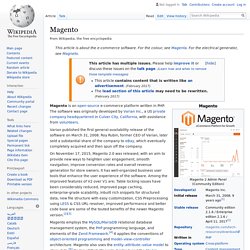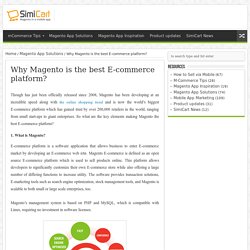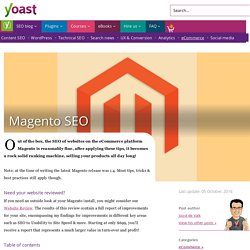

How to Maximize the Full Potential of Magento SEO. This post was sponsored by Mageworx.

Out of the box, Magento is equipped with a bunch of SEO features that let store owners configure page URLs, optimize meta data, generate sitemaps. But as we all know, search engine optimization is an ever-changing entity. To stay in line with the latest changes in the SEO environment, one needs to implement a complex set of measures — some of them easily done in the backend, while others require getting an advanced ready-to-apply solution.
MageWorx.Com, a certified Magento developer, presents SEO Suite Ultimate — all-in-one Magento SEO toolkit. MageWorx Magento SEO extensions are developed according to the latest industry trends and maximize the SEO potential of the eCommerce platform. This is what SEO Suite Ultimate is capable of: Managing Vast Amounts of Meta Data Managing meta data for Magento product pages can be a challenge. Our extension fully automates this time-consuming process. Optimizing Category and Product Reviews Pages Managing Hreflang Tags. Magento. Magento is an open-source e-commerce platform written in PHP.

The software was originally developed by Varian Inc., a US private company headquartered in Culver City, California, with assistance from volunteers. Varian published the first general-availability release of the software on March 31, 2008. Roy Rubin, former CEO of Varian, later sold a substantial share of the company to eBay, which eventually completely acquired and then spun off the company. Magento employs the MySQL/MariaDB relational database management system, the PHP programming language, and elements of the Zend Framework.[4] It applies the conventions of object-oriented programming and model–view–controller architecture. Magento also uses the entity–attribute–value model to store data.[5] On top of that, Magento 2 introduced the Model-View-ViewModel pattern to its front-end code using the JavaScript library Knockout.js.[6] History[edit] Varian, the company owning Magento, formerly worked with osCommerce.
Overview[edit] Why Magento is the best E-commerce platform? E-commerce platform is a software application that allows business to enter E-commerce market by developing an E-commerce web site.

Magento E-commerce is defined as an open source E-commerce platform which is used to sell products online. This platform allows developers to significantly customize their own E-commerce store while also offering a large number of differing functions to increase utility. The software provides transaction solutions, E-marketing tools such as search engine optimization, stock management tools, and Magento is scalable to both small or large scale enterprises, too.
Magento’s management system is based on PHP and MySQL, which is compatible with Linux, requiring no investment in software licenses. 6 Features That Make Magento One of the Best eCommerce Platforms Around. One of the many things that gives Magento an edge over other eCommerce platforms is the large array of features it comes loaded with.

Called the “platform for growth”, Magento is famous for its flexibility, scalability, and robustness that has also been praised by experts in the eCommerce industry. Created to serve the dynamic needs of eCommerce businesses and marketers all over the world, Magento has made a special place in the industry because of the features it offers and the endless possibilities it brings to your business as it strives to gain a competitive edge in the market.
Here’s a look at some of the top features of Magento that you can add to your e-store and turn it into a highly secure, user-friendly, and attractive online shopping experience. 1. Setting Variable Prices for Select Customers: We’re living in a time when customers have a ton of options to choose from while shopping around if they don’t like the price offered. 2. 3. Magento SEO - The Definitive Guide. 2 Magento Template Optimization 2.1 Headings By default the logo is an <h1>, which is should only be on the front page, and on all other pages it should be no more than an <h3>.

The most important thing is to get the title of the content in an <h1>tag, e.g. for a category page should it be the category name and for a product the product name. The next step is to clean up the over usage of headings. It’s a good idea to get rid off the header usage in the side columns, or make the text relevant to the shop (ie. include keywords). To learn more about why proper headings are important read this article on headings and why you should use them. 2.2 Clean up your code All that javascript and CSS you might have in your template files, move that to external javascripts and css files, and keep your templates clean, as they’re not doing your Magento SEO any good. 2.3 Aim for speed A very important factor in how many pages a search engine will spider on your shop each day, is how speedy your shop loads. Magento Features and how to use them. SEO Best Practices For eCommerce Product Pages.